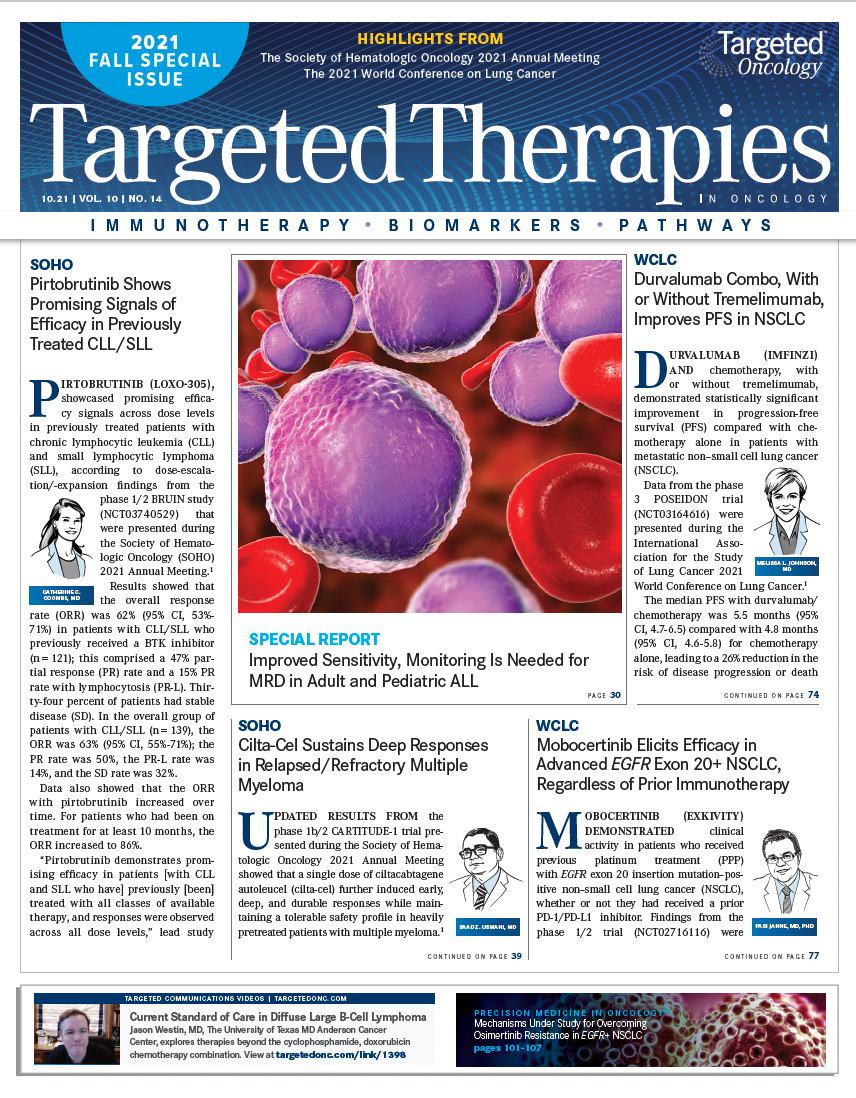Mobocertinib Elicits Efficacy in Advanced EGFR Exon 20+ NSCLC, Regardless of Prior Immunotherapy
Findings from the phase 1/2 trial of mobocertinib show clinical activity in a subset of patients with EGFR exon 20-positive non–small cell lung cancer.
Pasi A. Jänne, MD, PhD

Mobocertinib (Exkivity) demonstrated clinical activity in patients who received previous platinum treatment (PPP) with EGFR exon 20 insertion mutation–positive non–small cell lung cancer (NSCLC), whether or not they had received a prior PD-1/PD-L1 inhibitor. Findings from the phase 1/2 trial (NCT02716116) were presented during the International Association for the Study of Lung Cancer 2021 World Conference on Lung Cancer.1
Results showed that in the overall PPP subset (n = 114), the confirmed overall response rate (ORR) via an independent review committee (IRC) was 28% (95% CI, 20%-37%) and the disease control rate (DCR) was 78% (95% CI, 69%-85%). Additionally, among those in the PPP subset who had received prior PD-1/PD-L1 therapy (n = 48), the confirmed ORR via IRC was 25% (95% CI, 14%-40%) and was 30% (95% CI, 20%-43%) in those who had not received prior checkpoint blockade (n = 66).
The confirmed ORR via investigator assessment in the overall subset was 38% (95% CI, 24%-53%) and 33% (95% CI, 22%-46%), respectively.
“The safety profile of mobocertinib was consistent with the EGFR TKI class and manageable in both populations,” said lead study author Pasi A. Jänne, MD, PhD, director of the Lowe Center for Thoracic Oncology, the Belfer Center for Applied Cancer Science, and the Chen-Huang Center for EGFR Mutant Lung Cancers at Dana-Farber Cancer Institute.
“These results suggest that mobocertinib is effective in platinum-pretreated patients that have an EGFR exon 20 insertion mutation, regardless of the sequence of treatment with prior anti– PD(L)-1 therapies.”
On September 15, 2021, the FDA granted accelerated approval to mobocertinib for adult patients with locally advanced or metastatic NSCLC with EGFR exon 20 insertion mutations, as detected by an FDA-approved test, whose disease has progressed on or after platinum-based chemotherapy.2
Up to 12% of patients with EGFR-mutated NSCLCs have EGFR exon 20 insertion mutations.3 Mobocertinib is an oral, first-in-class, irreversible EGFR tyrosine kinase inhibitor targeting EGFR exon 20 insertion mutations in NSCLC.
In the 3-part, phase 1/2 trial, investigators are exploring the efficacy and safety of mobocertinib in PPP with locally advanced or metastatic NSCLC who have EGFR in-frame exon 20 insertion mutations, in subsets with and without prior PD-1/PD-L1 inhibitors. The study also consists of dose-escalation, -expansion, and -extension (EXCLAIM) cohorts.
From all 3 trial parts, patients who had previously received platinum-based chemotherapy were included. All had an ECOG performance status of 0 to 1 and had received at least 1 prior line of therapy for locally advanced or metastatic disease. Mobocertinib was administered at 160 mg daily.
The primary end point was confirmed ORR per RECIST 1.1 criteria as assessed by an IRC; secondary outcome measures were investigator-assessed ORR, IRC-assessed DCR, duration of response (DOR), and PFS. Overall survival (OS) was also assessed. All patients who received at least 1 dose of mobocertinib were evaluable for safety.
Part 1 of the trial, the dose-escalation phase, was a 3 + 3 design of patients with advanced NSCLC and an ECOG performance score of 0 to 2; 6 patients had prior platinum-based therapy.
Part 2 was the expansion phase, in which mobocertinib was given at 160 mg daily. The primary end point was ORR via RECIST 1.1 criteria; secondary end points were safety, tolerability, pharmacokinetics, and efficacy.
Part 3 of the trial, the EXCLAIM extension cohort, included patients with previously treated EGFR exon 20 insertion mutation–positive disease (n = 96; PPP [n = 86]).
There are 6 cohorts within part 2 of the study (FIGURE1); those with prior platinum-based therapy and refractory EGFR exon 20 insertion mutations with no active measurable central nervous system (CNS) metastases; refractory HER2 exon 20 insertion or point mutations and no active, measurable CNS metastases (cohort 2); refractory EGFR or HER2 exon 20 insertions or point mutations with measurable active CNS metastases (cohort 3); treatment-naïve or refractory other EGFR mutations, with or without T790M mutations, and uncommon EGFR mutations (cohort 4); refractory EGFR exon 20 insertion mutations with prior response to an EGFR TKI (cohort 5); treatment-naïve EGFR exon 20 insertion mutations (cohort 6); and refractory other tumor types (non-NSCLC) with EGFR/ HER2 mutations (cohort 7).
The findings presented at the conference comprised all PPPs from all 3 trial parts (n = 114). The data cutoff date was November 1, 2020.
In the PPP population, 49 patients (43%) had received prior immunotherapy, either as monotherapy or in combination with chemotherapy. Among those who had received prior PD-1/PD-L1 therapy (n = 48), 32 (67%) had received at least 2 prior lines of systemic anticancer therapy and 28 (58%) had immunotherapy as their most recent treatment.
The median age was 60 years (range, 27-84), and 66% of patients were female; 60% of patients were Asian and the majority (98%) had adenocarcinoma. Most patients (75%) had an ECOG performance status of 1 and were never-smokers (71%). Patients had received 1 (41%), 2 (32%), or more than 3 (27%) prior systemic anticancer regimens. The median number of prior regimens was 2. Thirty-five percent of patients had brain metastases at baseline.
Additional findings showed that, in the PPP subset of patients who did and did not receive PD-1/PD-L1 inhibition, the median DOR with mobocertinib was 17.5 months (95% CI, 3.7- not estimable [NE]) and 11.0 months (95% CI, 3.8-17.5), respectively; the DOR at 6 months or more via IRC was 58% and 60%, respectively. The confirmed DCR in this subset who had previously received PD-1/PD-L1 inhibition was 77% (95% CI, 63%-88%) compared with 79% (95% CI, 67%-88%) for those who had not received prior checkpoint inhibitors.
The median PFS in each group was similar at 7.4 months (95% CI, 5.5-21.1) and 7.3 months (5.4-10.2), respectively. The respective median OS was 21.1 months (95% CI, 13.1-NE) and 24.0 months (95% CI, 13.1-NE).
Furthermore, there were no marked differences between the 2 cohorts regarding best change from baseline in target lesion volume and duration of treatment in confirmed responders, both by IRC assessment, Jänne noted.
Regarding safety, treatment-related adverse events (TRAEs) occurred in 100% of patients with and patients without prior PD-1/PD-L1 inhibitor therapy. Grade 3 or higher TRAEs occurred in 58% and 39% of patients, respectively, and serious treatment-emergent adverse events (TEAEs) in 54% and 45% of patients, respectively.
Furthermore, drug discontinuation due to TEAEs occurred in 21% of patients who had received prior PD-1/PD-L1 inhibition and in 14% of those who had not received the class of agents. TEAE-related dose modification rates were 77% and 55%, respectively.
Common TRAEs (≥20% patients) in the prior or no PD-1/PD-L1 treatment cohorts included: diarrhea (94% vs 89%, respectively), rash (42% vs 47%), paronychia (27% vs 45%), decreased appetite (33% vs 36%), vomiting (35% vs 26%), increased blood creatinine (23% vs 27%), anemia (21% vs 15%), nausea (42% vs 29%), dry skin (35% vs 27%), stomatitis (21% vs 26%), pruritus (19% vs 23%), increased amylase (21% vs 17%), dermatitis acneiform (21% vs 17%), increased lipase (23% vs 17%), and fatigue (23% vs 8%).
Interstitial lung disease was reported in 1 patient in the PPP subset that had not received prior PD-1/PD-L1 therapy.
Of note, the label for mobocertinib includes a boxed warning for heart rate–corrected QT (QTc) prolongation including Torsade de pointes. Prescribers should require monitoring of QTc and electrolytes at baseline and periodically during treatment. If patients present with risk factors for QTc prolongation, increased monitoring frequency is recommended. Further, concomitant drugs known to prolong the QTc interval and the use of strong or moderate CYP3A inhibitors should be avoided. Mobocertinib should be withheld, the dose reduced, or the drug permanently discontinued based on the severity of QTc prolongation.4
REFERENCES:
1. Jänne PA, Ramalingam SS, Kim TN, et al. Mobocertinib in platinum-pretreated EGFR exon 20 insertion+ metastatic NSCLC patients with/without prior anti-PD(L)-1 therapy. Presented at: International Association for the Study of Lung Cancer 2021 World Conference on Lung Cancer; September 8-14, 2021; Virtual. Abstract FP09.01.
2. FDA grants accelerated approval to mobocertinib for metastatic non-small cell lung cancer with EGFR exon 20 insertion mutations. FDA. Updated September 16, 2021. Accessed September 21, 2021. bit.ly/3EFY1tm
3. Burnett H, Emich H, Carroll C, Stapleton N, Mahadevia P, Li T. Epidemiological and clinical burden of EGFR exon 20 insertion in advanced non-small cell lung cancer: a systematic literature review. PLoS One. 2021;16(3):e0247620. doi:10.1371/journal.pone.0247620
4. Exkivity. Prescribing information. Takeda Pharmaceuticals; 2021. Accessed September 21, 2021. bit.ly/39rF2nK

Advances in Subsequent Therapies Shake Up Sequencing of ccRCC Treatment
April 25th 2024With the approval of belzutifan and other newer data for treating patients with recurrent renal cell carcinoma, the state of subsequent therapies is advancing beyond the reuse of frontline options with impacts on duration of response and quality of life.
Read More
Emphasizing the Need for NGS in Advanced NSCLC to Determine Treatment
April 23rd 2024During a Case-Based Roundtable® event, Joshua Sabari, MD, led a discussion on the need for next-generation sequencing to determine treatment in patients with EGFR-positive advanced non–small cell lung cancer in the first article of a 2-part series.
Read More
Novel Approaches Focus on Limiting Toxicity in Older Patients With ALL
April 22nd 2024The major challenges for clinicians treating older patients with acute lymphoblastic leukemia surround the emergence of resistance to existing therapies and the toxicities associated with current chemotherapies.
Read More